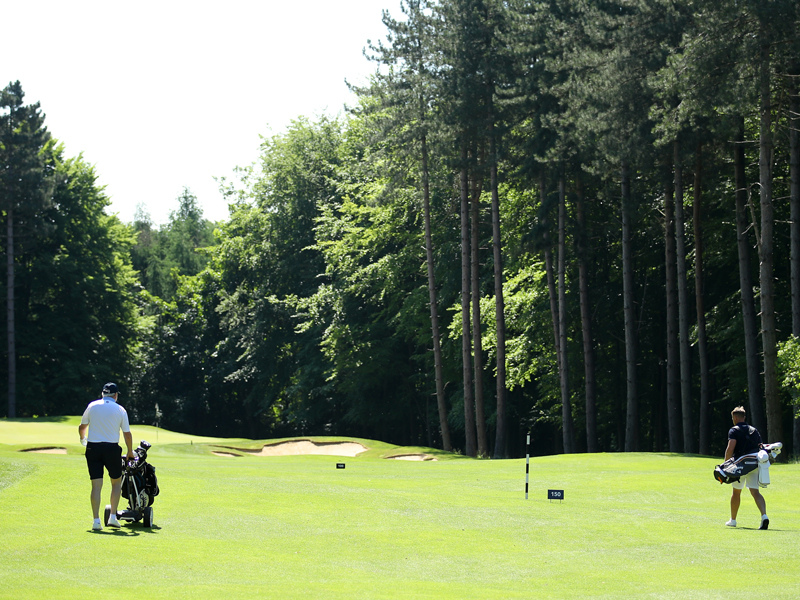Should Twoball Golf Become The New Norm?
What's more important - pace of play or maximising revenue?


Fergus Bisset and Jeremy Ellwood debate the pros and cons of more extensive twoball golf. Would an improved pace of play make up for the possible loss of revenue?
Should Twoball Golf Become The New Norm?
Yes says Fergus Bisset
One of the very best things about the post-lockdown return to golf was the rapid flow of play golfers enjoyed at courses up and down the country.
This, across the board, speeding up of our great game was largely triggered by the majority of us golfing only in twoballs.
A commonly cited obstacle for those considering taking up golf, or taking on a club membership, is the length of time an 18-hole round takes.
Twoball-only golf could remove this barrier, sparking life back into the game and drawing people in.
Get the Golf Monthly Newsletter
Subscribe to the Golf Monthly newsletter to stay up to date with all the latest tour news, equipment news, reviews, head-to-heads and buyer’s guides from our team of experienced experts.
Completing rounds in three hours or less post-lockdown was a breath of fresh air.
Already keen golfers relished the lack of waiting on tees and fairways whilst receiving a clear demonstration of how golf might be changed to appeal to a broader spectrum of the population.
For a glorious spell, people were able to fit golf into their day, rather than golf consuming their day.
Golf returned to being simply a fun and healthy, fast-moving sporting activity rather than a time-sapping commitment.
In terms of socialising, golfing in a twoball is not found wanting.
It provides a real opportunity to chat properly to an individual, either to catch up with, or get to know them.
For those who really want to play in their usual fourball, then why not try foursomes?
It’s a great and underplayed format and it allows for even faster rounds if done properly.
Alternatively; play in twos and meet up after the round to debrief.
Historically, a large proportion of golf was played in twoballs or foursomes and round times were rarely over three hours.
Somewhere along the path golf lost its way but the Coronavirus has provided an opportunity for the sport to get back on track.
We should grasp that opportunity and, once again, make twoball golf the norm.
Should Twoball Golf Become The New Norm?
No says Jeremy Ellwood
Many golf club members relished whizzing round in three hours or less as post-lockdown golf resumed for twoball play only, and there was a real buzz about speedy round times on social media.
But we were in a honeymoon period then - just relieved to be back out there after being starved of our passion for weeks - and great though it was, twoball only golf just wouldn’t be universally sustainable, or desirable, going forwards.
Clubs that were finding it hard before lockdown wouldn’t be able to maximise revenue, and bustling clubs would struggle to meet demand and keep all members happy.
Yes, some nomadic golfers might be tempted back into the membership fold if round times really were three hours maximum, but the likelihood is that this would be negated by those for whom club membership would become less appealing if they could no longer play their regular three- or fourball with their best mates.
Perhaps clubs should consider providing a few more dedicated twoball only slots on their tee sheets to satisfy those for whom speed really is of the essence if they are to find club membership attractive, but anything more than that would prove counterproductive, I fear.
Little Aston was one club to announce something along these lines, going for twoballs until midday and three- and fourballs after that from early June, but of course, even this won’t suit everybody.
Therein lies one of golf’s greatest challenges – trying to keep hundreds of people with different wants, desires, availability and free time all happy, a herculean task for any golf club administrator.
So, let’s not make twoball golf the new norm, but rather provide a little more opportunity for it for those for whom it really does make a big difference.
For more golf news do not forget to follow Golf Monthly on Facebook, Twitter and Instagram.

Fergus is Golf Monthly's resident expert on the history of the game and has written extensively on that subject. He has also worked with Golf Monthly to produce a podcast series. Called 18 Majors: The Golf History Show it offers new and in-depth perspectives on some of the most important moments in golf's long history. You can find all the details about it here.
He is a golf obsessive and 1-handicapper. Growing up in the North East of Scotland, golf runs through his veins and his passion for the sport was bolstered during his time at St Andrews university studying history. He went on to earn a post graduate diploma from the London School of Journalism. Fergus has worked for Golf Monthly since 2004 and has written two books on the game; "Great Golf Debates" together with Jezz Ellwood of Golf Monthly and the history section of "The Ultimate Golf Book" together with Neil Tappin , also of Golf Monthly.
Fergus once shanked a ball from just over Granny Clark's Wynd on the 18th of the Old Course that struck the St Andrews Golf Club and rebounded into the Valley of Sin, from where he saved par. Who says there's no golfing god?
-
 'One Gnome Per Patron' - My Morning In The Incredible Masters Shop
'One Gnome Per Patron' - My Morning In The Incredible Masters ShopAfter queueing for 40-minutes and spending almost $400, Elliott Heath recalls the exhilarating experience of shopping at The Masters...
By Elliott Heath Published
-
 Thanks To This New Masters Feature We Know One Tour Pro Hit Over 200 Balls Today At Augusta…
Thanks To This New Masters Feature We Know One Tour Pro Hit Over 200 Balls Today At Augusta…The new Practice Range Tracker introduced at The Masters has revealed the one player who really put the work in on Tuesday ahead of the first Major of the year
By Mike Hall Published